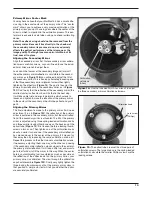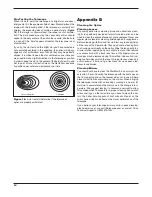
8
Altitude and Azimuth (Aiming the Telescope)
Your StarBlast 4.5 telescope’s base permits motion along two
axes: altitude (up/down) and azimuth (left/right) (
Figure 9
).
Both motions can be made simultaneously and in a continuous
manner for easy aiming. This way you can point to any position
in the night sky, from horizon to horizon.
The altitude axis rotation tension is adjustable with the altitude
tension adjustment knob (
Figure 2
). You want sufficient friction
of motion to keep the telescope from rotating too freely, which
can make it difficult to land on and stay aimed at an object you
wish to view. However, if you apply too much tension the tele-
scope will be difficult to move smoothly and in small increments
needed to center an object in the eyepiece for viewing. Turn the
tension adjustment knob to set the right amount of friction.
The rotation tension of the azimuth axis is set at the factory
and should allow smooth, easy rotation of the base to the left
or right.
Focusing the Telescope
The StarBlast 4.5 comes equipped with a 1.25” rack-and-pinion
focuser (
Figure 5
). We recommend practicing focusing in the
daytime when starting out to get the hang of it. With the 20mm
eyepiece inserted into the focuser, aim the optical tube so the
front (open) end is pointing in the general direction of an object
at least 1/4-mile away. With your fingers, slowly rotate either of
the two the focus knobs (they rotate in unison) until the object
comes into sharp focus. Go a little bit beyond sharp focus until
the image starts to blur again, then reverse the rotation of the
knob gradually, until you’ve nailed the exact focus point.
You can adjust the position of the focuser to the angle that
is most comfortable for viewing by simply loosening the tube
clamp knob, then rotating the optical tube until the focuser is
where you want it.
IV. Using Your Telescope
Choosing an Observing Site
When selecting a location for observing, get as far away as
possible from direct artificial light such as street lights, porch
lights, and automobile headlights. The glare from these lights
will greatly impair your dark-adapted night vision. Avoid viewing
over rooftops and chimneys, as they often have warm air cur-
rents rising from them. Similarly, avoid observing from indoors
through an open (or closed) window, because the temperature
difference between the indoor and outdoor air will cause image
blurring and distortion.
If at all possible, escape the light-polluted city sky and head for
darker country skies. You’ll be amazed at how many more stars
and deep-sky objects are visible in a dark sky!
Cooling the Telescope
All optical instruments need time to reach “thermal equilib-
rium.” The bigger the instrument and the larger the temperature
change, the more time is needed. Allow at least 20 minutes for
your telescope to acclimate to the temperature outdoors before
you start observing with it.
Let Your Eyes Dark-Adapt
Don’t expect to go from a lighted house into the darkness of the
outdoors at night and immediately see faint nebulas, galaxies,
and star clusters—or even very many stars, for that matter. Your
eyes take about 30 minutes to reach perhaps 80% of their full
dark-adapted sensitivity. As your eyes become dark-adapted,
more stars will glimmer into view and you’ll be able to see faint-
er details in objects you view in your telescope.
To see what you’re doing in the darkness, use a red-filtered
flashlight rather than a white light. Red light does not spoil your
eyes’ dark adaptation like white light does. A flashlight with a
red LED light is ideal. Beware, too, that nearby porch lights,
street lights, and car headlights will ruin your night vision.
“Seeing” and Transparency
Atmospheric conditions vary significantly from night to night.
“Seeing” refers to the steadiness of the Earth’s atmosphere at
a given time. In conditions of poor seeing, atmospheric turbu-
lence causes objects viewed through the telescope to “boil.” If
you look up at the sky and stars are twinkling noticeably, the
seeing is poor and you will be limited to viewing at lower magni-
fications. At higher magnifications, images will not focus clearly.
Fine details on the planets and Moon will likely not be visible.
In conditions of good seeing, star twinkling is minimal and
images appear steady in the eyepiece. Seeing is best over-
head, worst at the horizon. Also, seeing generally gets better
after midnight, when much of the heat absorbed by the Earth
during the day has radiated off into space.
Especially important for observing faint objects is good “trans-
parency” – air free of moisture, smoke, and dust. All tend to scat-
ter light, which reduces an object’s brightness. Transparency is
judged by the magnitude of the faintest stars you can see with
the unaided eye (6th magnitude or fainter is desirable). If you
cannot see stars of magnitude 3.5 or dimmer then conditions
are poor. Magnitude is a measure of how bright a star is – the
brighter a star is, the lower its magnitude will be. A good star to
remember for this is Megrez (mag. 3.4), which is the star in the
Figure 10.
Megrez connects the Big Dipper’s “handle” to its
“pan.” If you cannot see Megrez, a magnitude 3.4 star, then
the viewing conditions are poor.
Содержание 10015
Страница 4: ...4 Figure 2 Anatomy of a great telescope the StarBlast 4 5 1 2 3 4 5 7 12 13 8 9 11 10 6...
Страница 15: ...15...



























